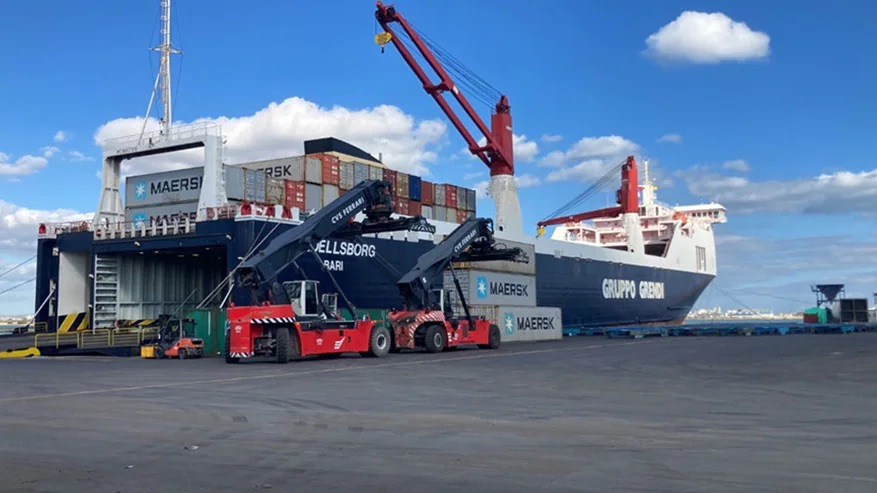Maersk, the renowned shipping container giant, has announced an ingenious plan to tackle the current issue of low water levels in the Panama Canal. In response to the authorities' limitation on the number of large ships passing through, Maersk will utilize a freight railroad as an alternative route.
According to Reuters, this strategic decision aims to maintain the company's commitment to timely deliveries and efficient operations.
Shifting Routes and Utilizing the Panama Canal Railway
Yahoo reported that Maersk's Oceania-Americas (OC1) service, which usually transits the canal via cargo ships, will now rely on the Panama Canal Railway. This 47-mile railroad runs parallel to the canal and effectively links the Atlantic and Pacific oceans.
By implementing this alternative route, Maersk aims to ensure seamless connections between Australia, New Zealand, and ports in Philadelphia and Charleston, South Carolina.
With the proposed changes, Maersk plans to create two separate rail loops dedicated to cargo destined for the Atlantic and Pacific. Pacific vessels will turn at the Port of Balboa in Panama, catering to cargo headed for Latin America, North America, Australia, and New Zealand.
Conversely, Atlantic vessels will turn at Panama's Port of Manzanillo, serving cargo destined for Latin and North America, Australia, and New Zealand. Although some southbound vessels may experience slight delays, Maersk does not anticipate any disruptions for northbound vessels docking in Philadelphia and Charleston.
Adapting to Dynamic Conditions
The decision to navigate the Panama Canal Railway stems from the unprecedented drought affecting Panama, resulting in reduced transits for larger container ships.
In light of these circumstances, container vessels traditionally relying on the Panama Canal to transport Asian exports to East and Gulf Coast ports have redirected their routes via the Suez Canal. The threat of piracy from Yemen's Houthi rebels prompted ships to begin rerouting from the Suez Canal, opting for longer oceanic voyages around the Cape of Good Hope.
Among the adjustments made, Maersk has decided to omit Cartagena, Colombia, which serves as the country's main export port. This strategic change aims to optimize cargo operations and streamline the supply chain amidst the prevailing challenges posed by low water levels in the Panama Canal.
Despite these adaptations, Maersk will continue operating its PANZ sailings, facilitating container transportation between Los Angeles, Oakland, Seattle, Australia, and New Zealand ports. The company remains committed to minimizing potential disruptions and constantly communicates with the Panama Canal Authority to provide timely updates.
Photo: Maersk Press Room



 Tesla’s Cybertruck Set to Make Its Debut in New Regions as October Deliveries Begin
Tesla’s Cybertruck Set to Make Its Debut in New Regions as October Deliveries Begin  Starbucks Japan Debuts Customizable Tumblers With Mini Aprons for 10th Anniversary
Starbucks Japan Debuts Customizable Tumblers With Mini Aprons for 10th Anniversary  Top Electric Vehicles You Can Lease for Under $300 a Month This September
Top Electric Vehicles You Can Lease for Under $300 a Month This September  At 60, the Sun hasn’t set – but the tabloid’s light is fading
At 60, the Sun hasn’t set – but the tabloid’s light is fading  XRP Healthcare Backs Trump for 2024, Shuns Ripple CEO's Support for Harris
XRP Healthcare Backs Trump for 2024, Shuns Ripple CEO's Support for Harris  Bordeaux’s Riot Skateshop Brings Wine to Nike SB Dunk Low; Air Max Plus Drops in Cotton Candy Colors
Bordeaux’s Riot Skateshop Brings Wine to Nike SB Dunk Low; Air Max Plus Drops in Cotton Candy Colors  Jack in the Box’s Monster Tacos and Mummy Wraps Return for Halloween 202
Jack in the Box’s Monster Tacos and Mummy Wraps Return for Halloween 202  Walmart’s Spicy Nuggets Rival Wendy’s Fan-Favorite with Extra Heat, Say Fans
Walmart’s Spicy Nuggets Rival Wendy’s Fan-Favorite with Extra Heat, Say Fans  Unlocking China: South Africa's Agricultural Trade Opportunities
Unlocking China: South Africa's Agricultural Trade Opportunities  Japanese Pizza Chain Expands Nationwide Delivery of Dog-Friendly Wanko Pizza
Japanese Pizza Chain Expands Nationwide Delivery of Dog-Friendly Wanko Pizza  Tesla Model 3 Tops Singapore’s Sedan Sales in August 2024, Outperforming Rivals
Tesla Model 3 Tops Singapore’s Sedan Sales in August 2024, Outperforming Rivals  Weaker iPhone 16 Demand Hits Apple Stock; Shorter Ship Times Raise Concerns
Weaker iPhone 16 Demand Hits Apple Stock; Shorter Ship Times Raise Concerns  Krispy Kreme Unveils Golden Harvest Doughnut Collection with Three New Fall Flavors
Krispy Kreme Unveils Golden Harvest Doughnut Collection with Three New Fall Flavors  Tesla Begins Hiring in Manila, Signaling Potential Expansion Into Philippine EV Market
Tesla Begins Hiring in Manila, Signaling Potential Expansion Into Philippine EV Market  Elon Musk, Larry Ellison Beg Nvidia CEO Jensen Huang Over Dinner for AI GPUs
Elon Musk, Larry Ellison Beg Nvidia CEO Jensen Huang Over Dinner for AI GPUs  Sam Altman Signals Profit-Driven Future for OpenAI as Nonprofit Structure Faces Overhaul
Sam Altman Signals Profit-Driven Future for OpenAI as Nonprofit Structure Faces Overhaul 































